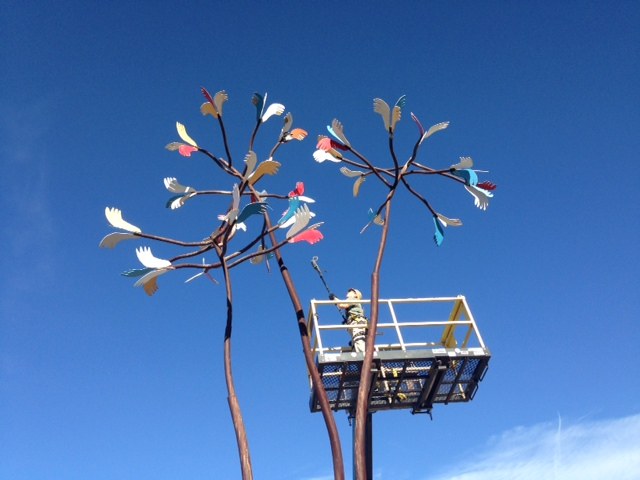
The ABQ BioPark Goes Wild
The majority of the BioPark’s focus is on the animals in the facility's care, but veterinary staff also helps wild animals in need.
Feb. 4, 2019 - The ABQ BioPark Zoo houses more than 1,000 animals, from birds to mammals and amphibians. The facility’s veterinary staff continually monitors and cares for these animals to keep them healthy and happy. But Zoo animals aren’t the only ones who receive top-notch vet care—injured wildlife also reaps these benefits.
In the last few months, ABQ BioPark vet staff has cared for an injured pelican, a variety of wild waterfowl from Tingley Beach, a sandhill crane and porcupine. According to Senior Veterinarian Dr. Carol Bradford, assisting wildlife when possible is the right thing to do.
“We’re a BioPark, not just a zoo, so it’s important for us to care for nature and the habitats around us, including wildlife,” she said. “I’d hate to turn them away, whether it’s a porcupine or a bird.”
One of the BioPark’s most recent wildlife rescue successes was an injured pelican found at Sandia Crest. The pelican arrived at the BioPark late last year. According to Bradford, the bird was lethargic and suffered from a hole in its throat pouch, which is used by pelicans to help drain water from their catch when fishing. Dr. Christine Fiorello repaired the pouch, and the bird was taken to Wildlife Rescue for more rehabilitation. Eventually, the pelican, which Bradford says was likely mid-migration flight, was released into the wild.
Although the BioPark occasionally cares for animals from across the metro or even other states, the majority of cases involve animals found on or near BioPark grounds. Bradford says it just makes sense to care for these animals instead of driving them across town to another facility.
Vet staff treats about 20 ducks and geese each year—most are wild birds that have been entangled in fishing line at Tingley Beach. This fishing line is difficult to remove, as it gets wrapped around the birds’ necks, legs and wings, and embedded into their skin. This is life threatening to these waterfowl. The good news is that ABQ BioPark vet staff has around a 60 percent release rate for tangled birds, which Bradford says is pretty good for wildlife rescue. The BioPark also occasionally removes fish hooks from birds’ mouths and treats waterfowl that have been hit by cars on Tingley Drive. Learn how you can help prevent this.
Waterfowl aren’t the only birds saved at Tingley Beach. Bradford laughingly recalled a rescue mission that she and a bird staffer successfully completed in late 2016. The two used a forklift to perform a rescue mission for a pigeon, which was trapped upside down by its wing inside a sculpture. She says that without their rescue efforts the bird would have died, but they were able to release it into the wild instead.
Vet staff occasionally encounters wild mammals too. Bradford says staff rescued a baby porcupine from the Cottonwood Gallery in spring 2017. After confirming that mom wasn’t coming back to care for the baby, staff rescued it and Wildlife Rescue took it in.
What You Can Do to Help Wildlife
Although most of us aren’t animal experts, we all can help wildlife! Here are some tips from Dr. Bradford.
- If you fish at Tingley Beach, use the receptacles provided to dispose of your fishing line. This will help protect the waterfowl.
- If you see a wild animal in distress on ABQ BioPark grounds, contact 505-259-4394. If the animal is not on BioPark grounds, it’s best to contact Wildlife Rescue at 505-344-2500. Review these pointers first.
- Remember that most of the time animals that seem to be in distress are probably OK. In the spring, many well-meaning citizens “rescue” fledgling birds on the ground that do not need rescue. Most of the time it’s best to leave these birds unless they are in immediate danger. Learn more about when and when not to help birds.
